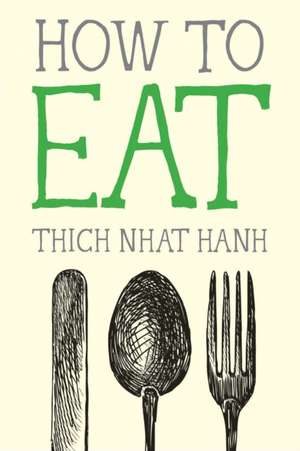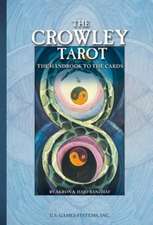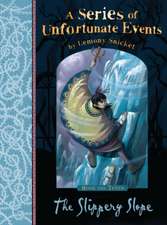How to Eat
Autor Thich Nhat Hanh Ilustrat de Jason DeAntonisen Limba Engleză Paperback – 25 aug 2014
Eating is a chance to return to the present moment.
How to Eat is the second in Parallax’s series of how-to titles by Zen Master Thich Nhat Hanh. These friendly, pocket-sized books contain several delightful illustrations by Jason DeAntonis, and are appropriate for those practicing in any spiritual tradition and all levels of familiarity with mindfulness practice.
How to Eat clearly and succinctly explains how you can incorporate eating as a form of meditation. The book provides practical advice on how to become truly nourished through the mindful preparation, serving, eating, and cleaning up of food.
Eating a meal in mindfulness reveals that you are nourished by the whole universe. This awareness helps develop compassion and understanding, reminding practitioners that there are things they can do to help nourish people who are hungry and lonely.
How to Eat encourages moderation and taking time to truly savor what we eat. By doing so, you too can become healthier, more fully enjoy what you eat, and help reduce waste.
How to Eat is the second in Parallax’s series of how-to titles by Zen Master Thich Nhat Hanh. These friendly, pocket-sized books contain several delightful illustrations by Jason DeAntonis, and are appropriate for those practicing in any spiritual tradition and all levels of familiarity with mindfulness practice.
How to Eat clearly and succinctly explains how you can incorporate eating as a form of meditation. The book provides practical advice on how to become truly nourished through the mindful preparation, serving, eating, and cleaning up of food.
Eating a meal in mindfulness reveals that you are nourished by the whole universe. This awareness helps develop compassion and understanding, reminding practitioners that there are things they can do to help nourish people who are hungry and lonely.
How to Eat encourages moderation and taking time to truly savor what we eat. By doing so, you too can become healthier, more fully enjoy what you eat, and help reduce waste.
| Toate formatele și edițiile | Preț | Express |
|---|---|---|
| Paperback (2) | 31.14 lei 22-33 zile | +10.11 lei 6-12 zile |
| Ebury Publishing – 7 iul 2016 | 31.14 lei 22-33 zile | +10.11 lei 6-12 zile |
| Parallax Press – 25 aug 2014 | 51.35 lei 3-5 săpt. |
Preț: 51.35 lei
Nou
Puncte Express: 77
Preț estimativ în valută:
9.83€ • 10.19$ • 8.19£
9.83€ • 10.19$ • 8.19£
Carte disponibilă
Livrare economică 06-20 martie
Preluare comenzi: 021 569.72.76
Specificații
ISBN-13: 9781937006723
ISBN-10: 1937006727
Pagini: 128
Ilustrații: line drawings throughout
Dimensiuni: 107 x 163 x 15 mm
Greutate: 0.09 kg
Editura: Parallax Press
ISBN-10: 1937006727
Pagini: 128
Ilustrații: line drawings throughout
Dimensiuni: 107 x 163 x 15 mm
Greutate: 0.09 kg
Editura: Parallax Press
Notă biografică
Thich Nhat Hanh was a world-renowned spiritual teacher and peace activist. Born in Vietnam in 1926, he became a Zen Buddhist monk at the age of sixteen. Over seven decades of teaching, he published more than 100 books, which have sold more than four million copies in the United States alone. Exiled from Vietnam in 1966 for promoting peace, his teachings on Buddhism as a path to social and political transformation are responsible for bringing the mindfulness movement to Western culture. He established the international Plum Village Community of Engaged Buddhism in France, now the largest Buddhist monastery in Europe and the heart of a growing community of mindfulness practice centers around the world. He passed away in 2022 at the age of 95 at his root temple, Tu Hieu, in Hue, Vietnam.
Extras
Eating a meal in mindfulness is an important practice. We turn off the TV, put down our newspaper, and work together for five or ten minutes, setting the table and finishing whatever needs to be done. During these few minutes, we can be very happy. When the food is on the table and everyone is seated, we practice breathing: “Breathing in, I calm my body. Breathing out, I smile,” three times. We can recover ourselves completely after three breaths like this.
Then, we look at each person as we breathe in and out in order to be in touch with ourselves and everyone at the table. We don't need two hours in order to see another person. If we are really settled within ourselves, we only need to look for one or two seconds, and that is enough to see our friend. I think that if a family has five members, only about five or ten seconds is needed to practice this “looking and seeing.”
After breathing, we smile. Sitting at the table with other people, we have a chance to offer an authentic smile of friendship and understanding. It is very easy, but not many people do it. To me, this is the most important practice. We look at each person and smile at him. Breathing and smiling together are very important practices. If the people in a family cannot smile at each other, the situation is a very dangerous one.
After breathing and smiling, we look down at the food in a way that allows the food to become real. This food reveals our connection with the Earth. Each bite contains the life of the sun and the Earth. The extent to which our food reveals itself depends on us. We can see and taste the whole universe in a piece of bread! Contemplating our food for a few seconds before eating, and eating in mindfulness, can bring us much happiness.
Having the opportunity to sit with our family and friends and enjoy wonderful food is something precious, something not everyone has. Many people in the world are hungry. When I hold a bowl of rice or a piece of bread, I know that I am fortunate, and I feel compassion for all those who have no food to eat and are without friends or family. This is a very deep practice. We do not need to go to a temple or a church in order to practice this. We can practice it right at our dinner table. Mindful eating can cultivate seeds of compassion and understanding that will strengthen us to do something to help hungry and lonely people be nourished.
Then, we look at each person as we breathe in and out in order to be in touch with ourselves and everyone at the table. We don't need two hours in order to see another person. If we are really settled within ourselves, we only need to look for one or two seconds, and that is enough to see our friend. I think that if a family has five members, only about five or ten seconds is needed to practice this “looking and seeing.”
After breathing, we smile. Sitting at the table with other people, we have a chance to offer an authentic smile of friendship and understanding. It is very easy, but not many people do it. To me, this is the most important practice. We look at each person and smile at him. Breathing and smiling together are very important practices. If the people in a family cannot smile at each other, the situation is a very dangerous one.
After breathing and smiling, we look down at the food in a way that allows the food to become real. This food reveals our connection with the Earth. Each bite contains the life of the sun and the Earth. The extent to which our food reveals itself depends on us. We can see and taste the whole universe in a piece of bread! Contemplating our food for a few seconds before eating, and eating in mindfulness, can bring us much happiness.
Having the opportunity to sit with our family and friends and enjoy wonderful food is something precious, something not everyone has. Many people in the world are hungry. When I hold a bowl of rice or a piece of bread, I know that I am fortunate, and I feel compassion for all those who have no food to eat and are without friends or family. This is a very deep practice. We do not need to go to a temple or a church in order to practice this. We can practice it right at our dinner table. Mindful eating can cultivate seeds of compassion and understanding that will strengthen us to do something to help hungry and lonely people be nourished.
Descriere
Descriere de la o altă ediție sau format:
"How to Eat" is part of the Mindfulness Essentials Series by Zen Master Thich Nhat Hanh, illuminating the basics of mindfulness practice. These short meditations cover everything from eating with others and enjoying our food to connecting with the Earth. Nhat Hanh inspires a joyful and sustainable relationship with all aspects of eating, including gardening, food shopping, preparing, serving, and even clearning up after a meal. "How to Eat" is a welcome reminder that the benefits of mindful eating are both personal and global.





















